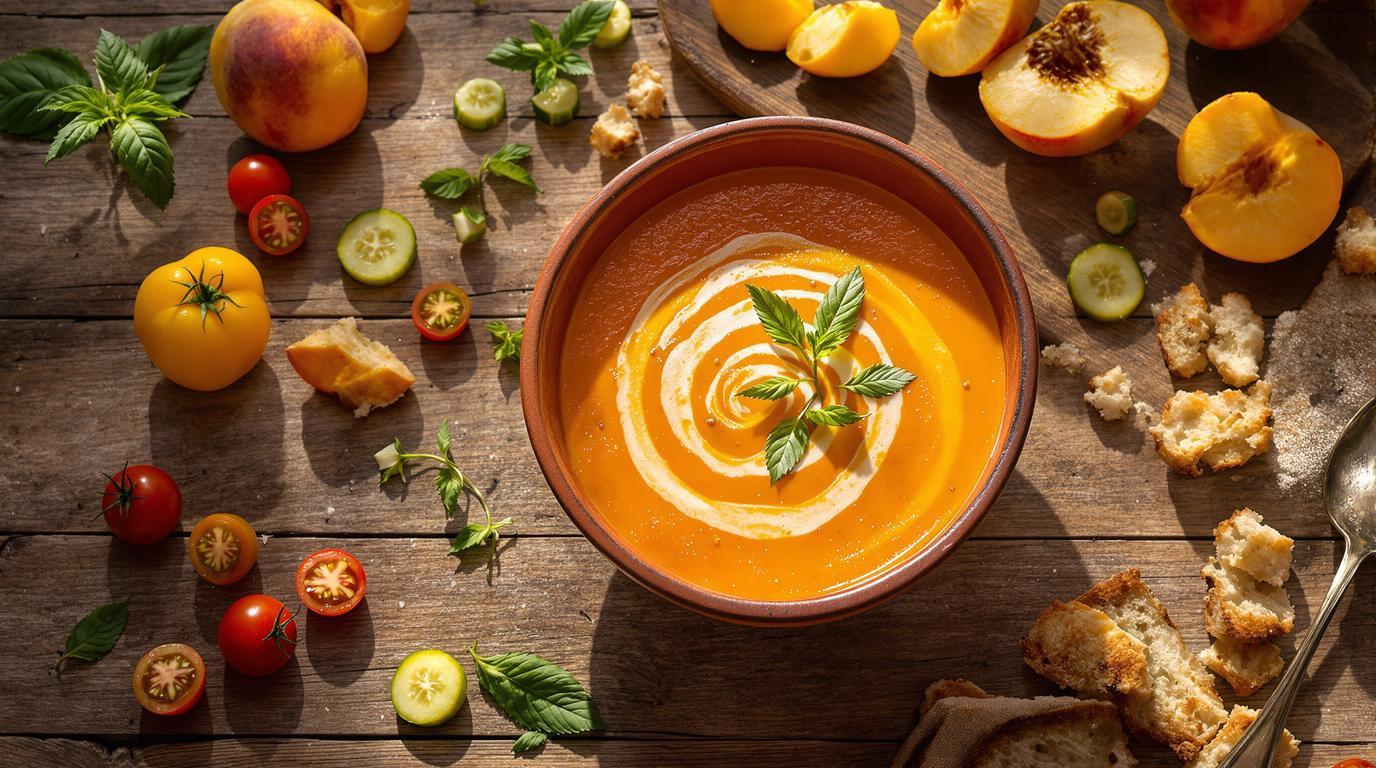The magic of gazpacho has always been its beautiful simplicity. I first encountered a peach-infused version while visiting a small village outside Seville, where an 80-year-old grandmother served her family’s twist on this classic Spanish dish. The combination of ripe summer peaches with garden-fresh tomatoes created something truly transcendent – sweet yet savory, refreshing yet substantial. Today, I’m sharing my adaptation of that unforgettable recipe, perfected over years in professional kitchens but remaining true to its humble roots.
The Story Behind Tomato Peach Gazpacho 📖
Traditional gazpacho originated as a peasant dish in Spain’s Andalusia region, where agricultural workers needed nourishing, no-cook meals during scorching summers. The earliest versions actually contained no tomatoes at all – just bread, olive oil, garlic, and vinegar pounded together in a mortar. When tomatoes arrived from the New World, they transformed gazpacho into the vibrant red soup we recognize today. This peach variation honors that evolution while celebrating summer’s perfect produce marriage.
Essential Ingredients 🧾
The soul of this gazpacho lies in its ingredients. You’ll need 1½ pounds (680g) of perfectly ripe heirloom tomatoes, 1 pound (450g) of fragrant yellow peaches, 1 cup peeled cucumber, ½ cup red onion, 2 garlic cloves, ¼ cup sherry vinegar, ½ cup stale rustic bread, ⅓ cup extra-virgin olive oil, 10 fresh basil leaves, and 1 teaspoon smoked paprika.
The ripeness of your tomatoes and peaches is absolutely critical – they should be fragrant and almost too juicy to hold. This isn’t the recipe for those pale, firm supermarket specimens. If truly ripe peaches aren’t available, mangoes can make a worthy substitute with their natural sweetness and slight acidity.
Step-by-Step Instructions 📝
- Begin by roughly chopping your tomatoes, peaches, cucumber, and red onion into chunks. There’s no need for precision here – everything will be blended.
- Tear your stale bread into pieces and soak in cool water for about 5 minutes, then squeeze dry with your hands. This traditional technique provides body without heaviness.
- Place all ingredients except the olive oil in your blender. Here’s where technique matters: pulse rather than puree! You’re aiming for a texture with tiny flecks of ingredients visible – not a completely smooth soup.
- With the blender running on low, slowly drizzle in the olive oil to create a silky emulsion, then season with about 1 teaspoon salt and ½ teaspoon freshly ground pepper.
- Transfer to a glass container and refrigerate for at least 2 hours, though overnight is significantly better as the flavors meld beautifully.
Chef’s Note: The vinegar balance is crucial in gazpacho. Add it gradually, tasting as you go – it should enhance the fruit’s natural acidity rather than dominate the flavor profile. This is where many home cooks go wrong, creating a soup that’s too sharp rather than harmonious.
Serving & Presentation Tips 🍽️
Serve your gazpacho in chilled bowls (I place mine in the freezer for 15 minutes before serving). A traditional garnish includes finely diced cucumber, peach, and homemade croutons, plus a drizzle of your best olive oil. This creates textural contrast against the smooth soup.
For a complete summer meal, pair with garlic-rubbed bruschetta and a glass of crisp Albariño wine. The combination is transportive – closing your eyes, you might just find yourself on a sun-drenched Spanish terrace.
Looking for more summer refreshment? Try my Chilled Ramen or 2-Ingredient Homemade Ice Pops for additional no-cook options. If you’re craving Mediterranean flavors, my Greek Yogurt Tzatziki Pasta delivers satisfaction in just 10 minutes, while my 15-Minute Caprese Chicken Pasta captures Italy’s summer essence perfectly. And don’t miss learning Grandma’s 6-Fold Trick for Heavenly Flaky Biscuits for the perfect accompaniment.
The beauty of gazpacho lies in its harmony of simplicity and depth. This humble soup tells the story of generations of Spanish cooks who understood that the freshest ingredients need minimal intervention. As you ladle this vibrant creation into bowls, remember you’re not just serving soup – you’re sharing culinary heritage transformed by summer’s most perfect offerings. ✨
